While Aeolus was the ruler of the winds, the winds themselves were separate minor deities in Greek mythology. The winds, known as Anemoi, were winged men who would soar over the earth, blowing from all directions. They were the sons of Eos and Astraeus. The most well-known were Boreas (north wind), Zephjyrus (west wind), Notus (south wind), and Eurus (southeast wind), though many others have been mentioned. Follow me to learn more about these minor, yet intriguing deities.
Key Facts
| Parents | Eos and Astraeus |
| Partners | Various |
| Siblings | The Astra Planeta (wandering stars) |
| Offspring | Various |
| Other names | – |
| Roman name | Venti |
| The God of | Winds, Seasons |
| Symbols | Wings, Anemoi Thuellai (storm winds) |
Names and Etymology
The name Anemoi is derived from the ancient Greek word ‘anemos,’ which translates to wind. The Anemoi are typically divided into two groups based on their prominence and the cardinal directions they represent. The more commonly mentioned quartet includes Boreas (North), Notus (South), Eurus (East), and Zephyrus (West). Their lesser-known counterparts, who are mentioned in the Tower of the Winds in Athens, are Kaikias (Northeast), Apeliotes (Southeast), Skiron (Northwest), and Lips (Southwest).
Each of the Anemoi has a unique name that reflects the direction of the wind they represent, embodying the essence of their being and the ancient understanding of the natural world. For instance, Boreas, the north wind, is often associated with the cold winter breeze, while Zephyrus, the west wind, is linked to the gentle spring winds. These names are not only poetic but are deeply ingrained in the ancient narratives that aimed to explain the unexplainable.
The Roman counterparts of the Anemoi, known as Venti, share a similar etymological background, with their names rooted in Latin words for wind and the respective directions. The transition from Greek to Roman mythology often carried over the core essence of these wind gods, albeit with a touch of Roman cultural interpretation. The names may have changed, but the reverence towards the natural forces they represented remained intact.
Anemoi Origins
The Anemoi are believed to be the offspring of Eos, the dawn, and Astraeus, the dusk. Their parentage symbolizes a beautiful narrative of how the winds are born from the daily dance between dawn and dusk. The union of these celestial entities gives birth to the winds that sweep across the land, embodying the continuous cycle of day and night.
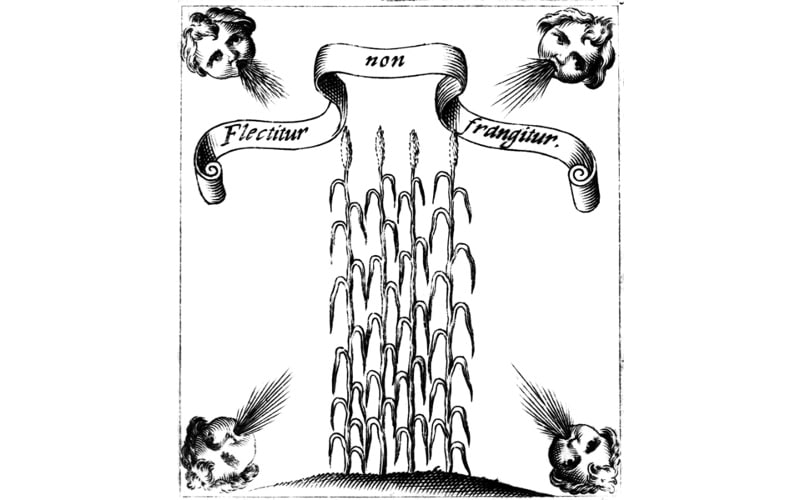
There isn’t a detailed narrative surrounding the birth or childhood of the Anemoi. However, their emergence is often seen as a natural consequence of their parents’ union. The Anemoi are not just mere characters in ancient stories; they are personifications of the unseen forces, Daemones (Spirits), that govern the natural world.
The Anemoi’s role as Daemones is crucial in understanding their significance in Greek mythology. They are not just whimsical characters but embody the ancient Greeks’ attempt to personify and understand the natural forces that shaped their lives. Their stories are not just tales of adventure but a reflection of a culture’s endeavor to explain the world around them.
Anemoi Lovers and Relationships
The romantic entanglements of the Anemoi are as varied as the winds they command. Each of the four primary wind gods has its own set of relationships that further enrich the Greek mythological landscape.
Boreas and Oreithyia
Boreas, the North Wind, is perhaps most famously known for his love affair with Oreithyia, a princess of Athens. Overcome by her beauty while she was playing along the Ilissos River, Boreas abducted Oreithyia and took her to his homeland, Thrace, where they were married.
Notus
Notus, the South Wind, doesn’t have a well-documented romantic relationship in the ancient texts. His role primarily revolves around bringing the warm and stormy winds of summer and autumn.
Eurus
Eurus, the East Wind, is another among the Anemoi whose romantic entanglements aren’t prominently featured in Greek mythology. He is often associated with bringing bad luck and is considered the least favorable among the Anemoi.
Zephyrus and Chloris
Zephyrus, the West Wind, is known for his relationship with Chloris, the goddess of flowers. Upon marrying her, he gifted her dominion over flowers, and she became associated with spring, further linking Zephyrus to the gentle breezes of the season.
Anemoi Offspring
The offspring of the Anemoi are as diverse as their parents, embodying various natural phenomena and contributing to the rich tapestry of Greek mythology.
Offspring of Boreas
Boreas and Oreithyia had several children who played significant roles in various myths. Their offspring include Khione, the goddess of snow, and the immortal horses, Zetes and Calais, who later joined the Argonauts in their quest for the Golden Fleece.
Offspring of Notus and Eurus
Notus and Eurus, being less featured in romantic narratives, doesn’t have a well-documented lineage of offspring in the ancient texts.
Offspring of Zephyrus
Zephyrus and Chloris bore a son named Karpos. Additionally, ancient sources also credit Zephyrus with fathering several other children, including the immortal horses Xanthus and Podargus, whom he had with the Harpy Podarge. Through these offspring, Zephyrus’ legacy weaves through various other mythological tales, vividly showcasing the interconnectedness of the ancient Greek mythological world.
Depiction And Characteristics
The Anemoi, often portrayed as handsome young men, each boast a pair of large, powerful wings, enabling them effortlessly to traverse the skies. Their appearances typically embody the characteristics of the winds they represent. For instance, illustrators depict Boreas, the embodiment of the northern wind, as a stern, heavily-muscled man with a beard, and hair seemingly made of ice, vividly reflecting the harsh, cold nature of the northern wind.
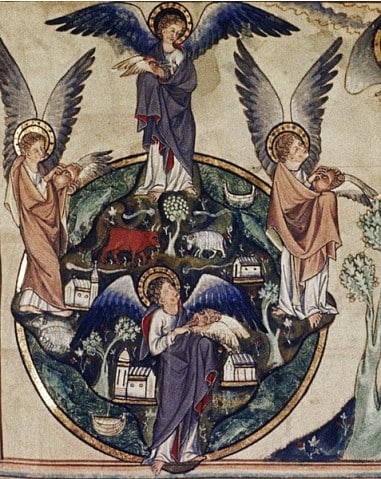
On the other hand, Zephyrus often embodies the gentle and warm west wind of spring, shown as a youthful figure. Transitioning to a different portrayal, the Winds either take the form of man-shaped, winged gods living together in a cavern on Mount Haimos (Haemus) in Thrake (Thrace), or horse-shaped divinities. Aiolos (Aeolus) Hippotades, known as “the Reiner of Horses,” stables them on the island of Aiolia, and later, sets them out to graze along the shores of the expansive River Okeanos (Oceanus).
Personalities
The personalities of the Anemoi exhibit as much variety as their appearances do. Boreas often embodies fierceness and violence, mirroring the harsh winter winds, whereas Zephyrus exudes gentleness and benevolence, akin to the soothing breezes of spring. Through various myths, their actions accentuate these traits, offering a glimpse into the ancient Greeks’ perception of the different winds. Moreover, the Anemoi’s powers are tied to their dominion over the winds. They possess the ability to control the direction and intensity of the winds, and their arrival frequently signals the change of seasons. Consequently, their mastery over such a fundamental aspect of nature underscores their significance in the ancient Greek pantheon.
Anemoi Roles And Responsibilities
The Anemoi had a crucial role in Greek mythology and the ancient Greeks’ understanding of the natural world. They were the harbingers of the changing seasons, each bringing a unique set of weather conditions with them.
Their responsibilities extended beyond merely controlling the winds. They were also seen as messengers of the gods, carrying divine messages across the vast lands. Their ability to traverse between the mortal realm and the divine showcases their significance and the respect they commanded among the other gods.
Myths about Anemoi
The Anemoi, being the personification of the winds, play pivotal roles in various Greek myths. Their interactions with other deities and mortals often reflect the unpredictable nature of the winds and their profound impact on the world.
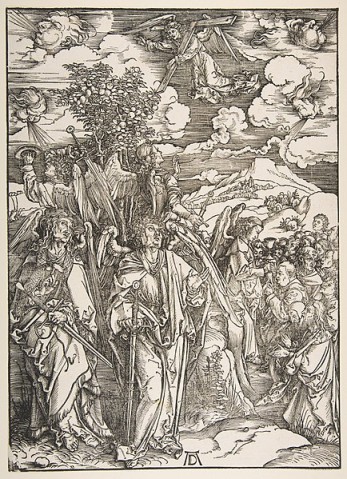
Boreas and the Golden Fleece
One of the most notable myths involving the Anemoi is the tale of Jason and the Argonauts in their quest for the Golden Fleece. Boreas’ sons, Zetes and Calais, were part of the Argonauts and aided in the journey. Their ability to fly, inherited from their father, proved invaluable in overcoming challenges, such as driving away the Harpies that tormented King Phineus. This myth showcases the divine lineage of the Anemoi and their involvement in heroic quests.
Boreas and Oreithyia
The classic tale of love and abduction unfolds through the love story between Boreas and Oreithyia, a princess of Athens. Enraptured by Oreithyia’s beauty, Boreas abducted her, subsequently whisking her away to Thrace. There, they united in marriage. This union resulted in the birth of Khione, the goddess of snow, and the immortal horses, Zetes and Calais. The tale not only explores the romantic entanglements of the Anemoi but also their interactions with the mortal realm.
Zephyrus and Hyacinth
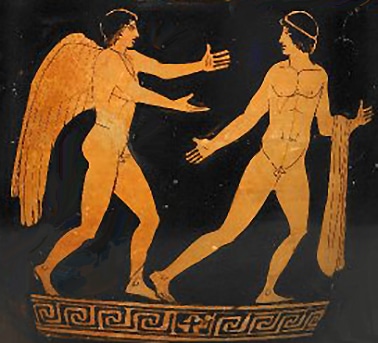
The tragic tale of Zephyrus and Hyacinth revolves around a love triangle involving Apollo, Zephyrus, and a beautiful youth named Hyacinth. Both Apollo and Zephyrus were smitten with Hyacinth. However, jealousy took hold of Zephyrus when he saw Hyacinth and Apollo enjoying a game of discus. In a fit of jealousy, Zephyrus blew the discus off course, causing it to strike Hyacinth and leading to his death. This myth underscores the themes of love, jealousy, and the sometimes capricious nature of the wind gods.
Zephyrus and Chloris
The tale of the gentle romance between Zephyrus and Chloris, the goddess of flowers, symbolizes the arrival of spring. Enamored by Chloris, Zephyrus marries her, and gifts her dominion over flowers. Often depicted, this union represents a harmonious blend of the gentle spring winds and the blooming beauty of nature, embodying the rejuvenating spirit of the season. Moreover, it showcases the lively interaction between the elements, bringing forth a fresh, new beginning with each spring.
Notus and the Stormy Seas
Notus, the embodiment of the south wind, frequently associates with stormy and turbulent seas, particularly in the autumn season. Various myths portray the winds of Notus as a formidable force, capable of agitating the seas and altering voyage courses. Particularly, these winds present a challenge for sailors and heroes as they navigate the unpredictable waters. This depiction reflects the ancient Greeks’ reverence and fear towards the mighty forces of nature.
Anemoi In Ancient Greek Religion
The Anemoi, though not as prominently worshiped as some other deities in the Greek pantheon, had their own unique place in the religious practices of ancient Greece.
Athens
In Athens, the primary city of Attica, Herodotus, a Greek historian from the 5th century BC, notably documented the worship of the Anemoi in his work “Histories.” According to his records, an oracle advised the Delphians to pray to the Anemoi for assistance against the invading Persians. Heeding this divine counsel, the Delphians then erected an altar to the Winds at Thyia and offered sacrifices to appease them, forging a hopeful alliance against the invaders.
The Athenians, too, invoked Boreas, the North Wind, based on an oracle’s advice to seek aid from their “son-in-law” – referring to Boreas’ marriage to the Athenian princess Oreithyia. The Athenians credited Boreas with aiding them against the Persian fleet, and in gratitude, they established a sacred precinct for Boreas beside the Ilissos river. This narrative illustrates the perceived intervention of the Anemoi in critical historical events and the subsequent religious reverence bestowed upon them.
Titane
In Titane, a town in Sicyon, locals intertwined the worship of the Anemoi with rituals dedicated to other deities. Pausanias, a Greek traveler and geographer of the 2nd century AD, documented this in his work “Description of Greece.” He noted that an annual nocturnal sacrifice to the Anemoi took place at an altar situated at the base of a hill. A priest performed this ritual, which involved secret rites. These rites aimed to temper the ferocity of the winds, showcasing the ancient belief in the Anemoi’s control over the natural elements. Transitioning to a broader perspective, this practice reflected the deep-rooted connection between the community and the natural world around them.
Coronea
Further, in Coronea, a town in Boeotia, Pausanias noted the presence of an altar dedicated to the Anemoi in the marketplace, indicating a communal reverence for these wind gods. The scattered yet significant mentions of the Anemoi in religious practices across different regions of ancient Greece reflect the enduring belief in their influence over the natural world and the desire to seek their favor or appeasement through religious rituals.
Representations Of Anemoi In Art
The Anemoi have been a source of inspiration in the realm of art, with various representations depicting their ethereal forms and the winds they command. These artistic portrayals span across different mediums and periods, reflecting the enduring fascination with these wind gods.
Vase Paintings
Ancient Greek vase paintings often featured the Anemoi, showcasing their winged forms amidst scenes of nature or divine gatherings. These artworks not only served as decorative pieces but also as a means to narrate mythological tales and the Anemoi’s roles within them. The depiction of the Anemoi in flight, with their wings spread wide, is a recurring theme in these vase paintings, symbolizing their dominion over the winds.
The Tower of the Winds
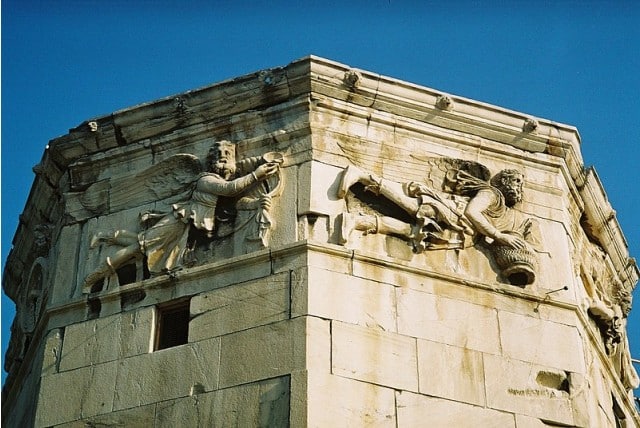
The Tower of the Winds, located in Athens, stands as a significant architectural and artistic tribute to the Anemoi. Built in the 1st century BC, this octagonal structure features a frieze depicting each of the eight wind gods in their distinct forms. The tower, considered to be the world’s first meteorological station, not only showcases the artistic representation of the Anemoi but also the ancient Greek’s advanced understanding of meteorology. The frieze serves as a visual guide to the different winds, each god carved in relief, embodying the direction of the wind they represent.
Mosaics
Mosaics from different periods of ancient Greek and Roman art also feature the Anemoi. These intricate pieces often portray the wind gods amidst scenes of nature, emphasizing their control over the elements. The use of mosaics as a medium allows for a vibrant depiction of the Anemoi, with each tile contributing to the portrayal of their ethereal beauty and power.
Sculptures
Artisans of the ancient era skillfully immortalized the Anemoi through sculptural representations, often incorporating them into larger architectural or memorial structures. They carved these sculptures from marble or cast them in bronze, encapsulating the essence of the Anemoi in a three-dimensional form, thereby vivifying the mythological tales of these wind gods. Moreover, through their adept craftsmanship, they forever captured the forms of the Anemoi in a dance with the winds they command, ensuring their legacy endures in stone and metal.
Mentions in Ancient Texts
Various ancient texts frequently mention the Anemoi, underscoring their importance in Greek mythology. Through the works of several notable authors from antiquity, they vividly highlight their roles and significance.
Homer’s “Odyssey” (circa 8th century BC)
Homer, author of the epic poems the “Iliad” and the “Odyssey,” mentions the Anemoi in his work “Odyssey.” In this epic, Aeolus, the keeper of the winds, gifts Odysseus a bag containing all the winds except the west wind. These Oudysseus are to use to help him return home. However, the winds escape and cause a storm due to the curiosity and mistrust of Odysseus’s crew. This narrative showcases the importance and the power of the Anemoi in ancient Greek beliefs.
Hesiod’s “Theogony” (circa 700 BC)
Hesiod, another revered ancient Greek poet, mentions the Anemoi in “Theogony.” He provides a detailed account of their parentage and their roles as the harbingers of seasonal change. In “Theogony,” Hesiod writes, “And after these Erigenia (the Early Born) bare the star Eosphorus (Dawn-bringer), and the gleaming stars with which heaven is crowned,” linking the birth of the Anemoi to the cosmic dance of dawn and dusk.
Virgil’s “Aeneid” (circa 29–19 BC)
Virgil, a classical Roman poet, also mentions the Anemoi in his epic “Aeneid.” In this work, the winds play a crucial role in various events. Highlighting the intertwined nature of the natural world and human destiny in ancient beliefs. Virgil’s narrative further solidifies the significance of the Anemoi across cultures, from Greek to Roman mythology.
Apollonius Rhodius’ “Argonautica” (3rd century BC)
Apollonius Rhodius, an ancient Greek author and librarian, mentions the Anemoi in his epic “Argonautica.” It tells the story of the adventures of Jason and the Argonauts. The winds, particularly Boreas’ sons, play a significant role in aiding the heroes on their quest for the Golden Fleece. Through this narrative, Apollonius Rhodius emphasizes the divine assistance the Anemoi provide to mortals on their heroic journeys.
Frequently Asked Questions
The Anemoi are the ancient Greek wind gods, each governing a cardinal direction of the wind. They are crucial figures in Greek mythology, representing the changing seasons and the natural world.
The Tower of the Winds is an ancient structure in Athens dedicated to the Anemoi. It features elaborate friezes depicting each of the eight wind gods and is a testament to their importance.
The Anemoi are believed to be the offspring of Eos, the dawn, and Astraeus, the dusk. Their parentage symbolizes the daily dance between dawn and dusk, giving birth to the winds.
One of the most famous myths is the abduction of Oreithyia by Boreas, the North Wind. Another is the myth of how Zephyrus cause Apollo to kill Hyacinth with a discus.
Yes, the ancient Greeks revered the Anemoi as powerful deities, intertwining their worship with their reverence for the natural world.
Featured Image Credit: Anonymous, Public domain, via Wikimedia Commons
